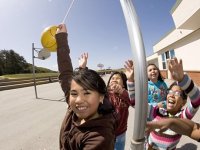Room to Move: Shared Use Creates Opportunities for Physical Activity
Regular physical activity is known to have positive effects on students’ academic performance. Physically inactive children tend to miss more days of school and deliver lower test scores, while regularly active kids show up to class focused and ready to learn.
Unfortunately, some kids have a harder time finding safe places to engage in physical activity. Communities across the country are seeking safe, accessible, and affordable places for children and their families to exercise and play. Although schools might have a variety of recreational facilities, they are often locked and remain inaccessible to students and the surrounding community during nonschool hours. Low-income communities and communities of color consistently have the fewest resources for physical activity. In those communities, schools are often the only place to find safe and affordable opportunities for recreation.
The good news is that, through shared use, schools can play an important role in increasing opportunities for physical activity that students and community members want and deserve.
What Is Shared Use?
Historically, schools have been community hubs. But many schools have closed their properties to the community due to concerns about maintenance, security, and liability. Shared use -- also called "joint use" or "community use" -- can help change that. Shared use occurs when schools partner with a municipality or private nonprofit organization and agree to open or broaden access to their facilities for community use.
Although schools and their surrounding jurisdictions are often entwined, they don’t always work together to promote student and community health. Shared use agreements and policies can fix this by marrying school wellness with community health to improve outcomes for everyone involved. Educators, who are often overlooked in the process, can play a major role in making shared use happen.
How Does It Work?
Advocates, partner organizations, or city employees working on behalf of community members will often approach an individual school or district to discuss a shared use partnership. However, there's no reason why educators shouldn't initiate the process. The steps outlined below (and which can be found here in greater detail) will ensure a smoother path to what will ultimately be a beneficial arrangement for the entire community.
Identify Community and School Needs
Do residents who live near your school have unmet needs in terms of recreation and physical activity? Are students suffering from health problems due to a lack of physical activity? What do you hear from students about where they play when school is not in session?
Consider Available Locations
Take an inventory of facilities to determine what is available. Identify places that best serve unmet needs like playgrounds, tracks, fields, and courts, or indoor facilities like gymnasiums.
Seek Out Partner Organizations
There's no need to do this alone. YMCAs and community-based organizations may also benefit from use of the facilities. Build relationships with them for worthwhile results.
Participate in Updating Your Local Wellness Policy
Wellness policies communicate the essential role that schools play in promoting student health, and many districts are now revising their policies to comply with new federal rules. By including shared use in your wellness policy, everyone will understand the important role this tool can play in promoting student and community health.
Find Your Cheerleader
Getting the school board and governing body of your local jurisdiction committed to the concept of shared use is critical to the process. In an era of budget shortfalls, making the most of existing facilities -- rather than developing new ones -- can be an efficient and economical use of public resources.
A Note About Liability
Many schools commonly point to liability as a reason to steer clear of shared use arrangements. What's not commonly known is that all 50 states have laws governing liability, and all offer some legal protection for public entities, including schools, in the event of injury or property damage. Liability concerns don't have to derail the process -- prudent risk management strategies such as regularly inspecting and maintaining property, carrying the proper insurance, and distributing legal risk through shared use agreements can often overcome any liability concerns that stand in the way of achieving a successful shared use partnership.
Making It Stick
Shared use agreements have many moving parts, and making them work requires a team effort. Work with your school's leaders and administrators, as well as community members, city officials, and legal counsel to decide what the agreement should look like.
For an agreement to work, it should be clear who will have priority access to the site, which entity will be responsible for maintenance and scheduling use of the resources, and who will provide the funds for ongoing upkeep. Sometimes, a city simply pays a school district a fixed amount per year for access to their facilities. Other times, cities agree to take on a school's liability in exchange for the school opening its gates. There is no single way to ensure a successful partnership. Organizations like ChangeLab Solutions can partner with you and your school as your develop the right approach for your community.
Physical activity is important to the well-being of our kids, and open spaces can bring a community together. Social engagement alone can have a positive impact on overall community health. Through shared use, schools can play a significant role in expanding opportunities for healthy and active living.
